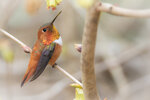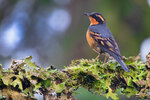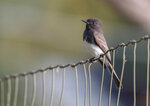



Check the calendar. It is a third of the way from the winter solstice to the summer solstice, and the birds have noticed. They’re beginning the spring migration.
Migration time for many species comes a month or two before breeding season. Exceptions include the large raptors, some of which migrate. Great Horned Owls don’t migrate and are likely to have been incubating eggs since late December; Bald Eagle, Red-tailed Hawks, and Ospreys, both migrants and residents, are just now sprucing up their nests and laying eggs.
Winter is very stressful for birds, either because of cold weather if they don’t migrate or, if they do, the challenge of flying hundreds if not thousands of miles. One adaptation most birds employ to handle the winter stress is the shutdown of their reproductive systems. Their reproductive organs shrink and, therefore, have reduced biological demand, freeing energy for other more vital activities. Scientists describe this quiescence as a state of “reversible growth arrest.”
And what reverses the shutdown? It’s the change in day length. The amount of change needed to stimulate migration and reproductive urges varies widely between species. The early migrants are showing up now, during what in some years is the middle of winter. Readers with hummingbird feeders likely will notice the return of male Rufous Hummingbirds. They arrive weeks before the females and seek to establish territories that they “hope” impress the females when they arrive.
Other early-arriving migrants are several species of swallows. There are numerous observations already of small flocks of Barn Swallows, as well as a few Tree, Violet-green and Bank swallows. Cliff Swallows, famous for returning to San Juan Capistrano, California, on March 19th, winter in South America and are unlikely to be seen here before late March. (The famous Capistrano date, incidentally, is likely the initiation of actual nesting rather than just the first appearance).
The reproductive impulses of our winter residents are also stimulated by the longer daylight hours. Ducks wintering here may not depart until March or April (when inland breeding ponds and wetlands finally open from winter’s grip). But that doesn’t stop ducks from courting. Almost anywhere you see ducks this month and next, you will see males competing for females’ attention. Following the competition, there will be mated pairs swimming close together. Later, they will migrate together.
Another example is a common local winter resident, the Varied Thrush. It nests at higher elevations that are still snow-covered, but that doesn’t stop the males from singing now as the days get longer. If you are near Varied Thrush habitat in the early morning hours, you likely will hear their distinctive fluting, a 2-second buzz with successive efforts at different pitches.
Varied Thrushes are robin-sized birds and are sometimes confused with them. They generally like wooded areas, but sometimes come out onto lawns and road edges. The males are beautiful, with a grey-black back, head and wings, and a rich burnt orange breast with a bold black stripe. They also have orange wing bars and an orange stripe over what looks like a black facemask. This mask has inspired generations of children to call them “robber birds.” Females have the same color pattern but duller with grey-brown replacing the black of males.
Last year a relatively rare bird for Washington, the Black Phoebe, was reported from many places in Western Washington (but not in Thurston County). These winter reports are increasing, making me wonder if last year’s birds bred successfully. Last weekend, a Black Phoebe was spotted near Tumwater Falls Park, so they are now a “local bird” that you might look for.
Unlike other flycatchers, Black Phoebes apparently stay around all winter. They’re almost sparrow-sized; however, they’re not on the ground like sparrows. They perch on open tree branches and other perches, darting out to catch flying insects and then returning to the same perch. They often are found near water and are said to sometimes take very small fish from the surface.
Black Phoebes are beautiful birds, with contrasting all-black above, a bright white belly and a distinctive peaked head. They’re not shy and are easily identified, which may account for their numerous sightings. However, it may also be that this species is expanding its range north from its native California.
Personal Note – The last few weeks I have been concentrating on writing about the Boldt decision that restored Indian fishing rights. This month, many are commemorating its 50th anniversary and the dramatic and welcome benefits it has brought.
Soon, the regular weekly bird column will return. If there are subjects you would like me to write about, please do not hesitate to contact me.
George Walter is environmental program manager at the Nisqually Indian Tribe’s natural resources department; he also has a 40+ year interest in bird watching. He may be reached at george@theJOLTnews.com
Photos for this column are provided by Liam Hutcheson, a 16-year-old Olympia area birder and avid photographer.
5 comments on this item Please log in to comment by clicking here
JoanneMc
Thanks for bringing these birds' activities to our attention. I hope you will continue to provide bird notes to our community, as they are certainly worthy of our attention and protection!
Friday, February 23 Report this
RondaLarsonKramer
Liam Hutcheson's photos are amazing.
Friday, February 23 Report this
wildnature
Thanks. This explains why a male rufus hummingbird is hanging around my pink flowering (now) deciduous rhody. I live isolated in rural T. Cnty, so no close neighbors with feeders to attract them to stay through winter, and I don't have a hummingbird feeder.
I see red tailed hawks get very active starting February above my towering Doug firs. It's exciting to know they are nesting and laying eggs right now. I love your bird articles George, and the informative two on the Bolt decision.
Friday, February 23 Report this
saiboro2
I do love birds though.
Friday, February 23 Report this
customers
Love the read. Very enlightening to me. I know a bit more about my humming bird friends.
Saturday, February 24 Report this